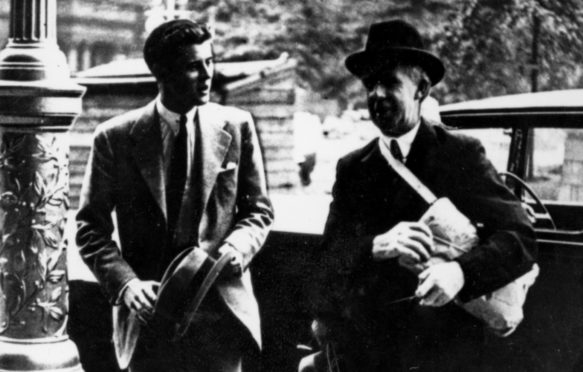
John F Kennedy’s first speech – to an angry and hostile crowd in a Scottish hotel – is detailed in a new biography of the iconic US president.
Aged 22, John F Kennedy was sent to Glasgow by his father Joseph, US ambassador to Britain, to address the surviving passengers of a ship torpedoed by a U-boat hours after Britain declared war on Germany.
Govan-built passenger liner SS Athenia, carrying 1,300 passengers that included 500 Jewish refugees, was the first ship to be sunk by Germany during the Second World War.
On September 3, two days after leaving Glasgow, it was sunk 200 miles west of the Hebrides. More than 100 passengers and crew were killed. Survivors were taken to Galway and Greenock.
JFK was sent by his father to speak to many of the survivors at the Beresford Hotel in Glasgow’s Sauchiehall Street. The event is detailed in JFK Volume 1: 1917-1956, written by Pulitzer-winning Harvard professor Fredrik Logevall, and described by a reviewer in The Times as the “most compelling biography I have read in years”.
Mr Logevall wrote: “Many of the rescued passengers were being brought to Glasgow, and the ambassador wanted Jack to be present as his representative. With the regular embassy staff now overloaded with work, he had no one else to send. The crowd that greeted Jack Kennedy at the Beresford Hotel demanded answers about what had occurred, as well as protection once they resumed their transatlantic voyage.”
The crowded shouted, insisting: “We refuse to go without a convoy!” According to newspaper reports, JFK showed “boyish charm and natural kindliness” and “wisdom and sympathy of a man twice his age” as he answered their questions.
He cited US President Franklin D Roosevelt’s assurance that convoys were unnecessary because Germany would not attack a neutral vessel. The US did not officially enter the war until two years later. This led to shouts by survivors of “What about the submarines? You can’t trust the German Navy! You can’t trust the German Government!”
JFK remained composed and assured, insisting above the noise of the crowd: “You will be safe on a ship flying the American flag under international law. A neutral ship is safe.”
JFK returned to the US to continue his studies at Harvard, graduating the following year and joining the US Navy. Mr Logevall wrote of JFK’s time in Europe: “It had been an astonishing seven months overseas, more consequential than he ever could have anticipated, more eventful, surely, than the experience of any Harvard junior that year – or perhaps any year.”
Professor Phillips O’Brien, chairman of Strategic Studies at the University of St Andrews, said: “The visit revealed that the young JFK could deliver a speech and undertake a public duty with empathy and panache. These skills were noted and would be important assets in his political rise to the presidency 21 years later.”

Enjoy the convenience of having The Sunday Post delivered as a digital ePaper straight to your smartphone, tablet or computer.
Subscribe for only £5.49 a month and enjoy all the benefits of the printed paper as a digital replica.
Subscribe